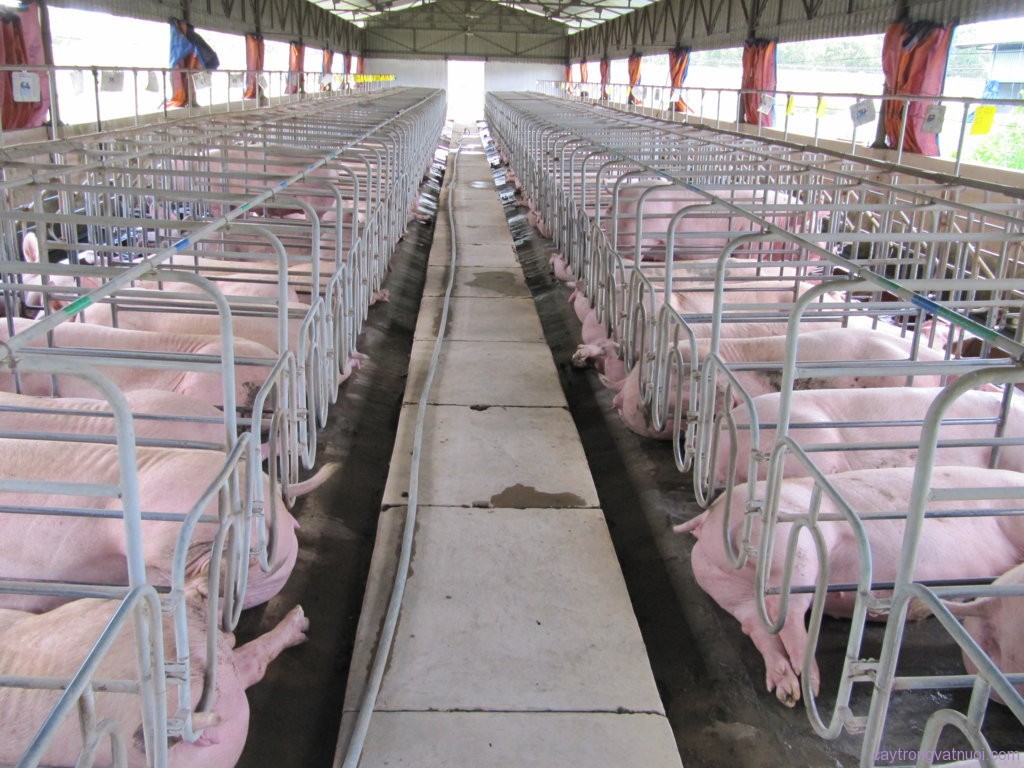The barn is an important factor that has a great influence on pig production. The experience of some foreign companies doing business and production in our country shows that the role of barns is decisive for pig production.
According to a Danish study, if the farm is located less than 230m from a farm infected with Mycoplasma and at the same time less than 2.25km from a large infected farm, the possibility of that pig farm being infected with Mycoplasma is 1/6. When pigs are infected with the pathogen Mycoplasma will cause respiratory diseases, making pigs stunted, slow to grow and at risk of spreading widely.
The eradication of Mycoplasma pathogens in the farm is very difficult because they can be transmitted in the air up to 4km. Especially when it is cold, the wind is strong and the humidity is high, their transmissibility becomes even stronger. In addition, some other diseases (such as Aujeszky, PRRS ...) can be transmitted in the air over short distances.
Spaniard Dr. Jose Barcelo: “If the camp is built in areas with high road density, then be prepared to deal with infiltration diseases”. Also according to Dr. Jose: “The number of pig farms within a radius of 5km (or number of farms / km2) greatly affects disease safety in the farm. If compared with areas with low density, a high density camp area is very dangerous in epidemic prevention ”.
Therefore, it is very important to build a pig farm to ensure the above standards to make it difficult for your flock to be infected with diseases from other farms or from the environment.
Here are some notes when building a pig farm you need to know:
1. Build a camp about 3 km away from another camp
When building a new camp, pay attention to the surrounding camps within a 5km radius. Not near the meat farms that regularly import and export pigs.
If the location within 3km does not allow building another pig farm, it is very good. In addition, the size and distance to the neighboring camps are also important. According to the Danish definition, large scale farms are over 500 heads.
According to Dr. Jose: "A farm of over 500 children with a distance of less than 1km is more dangerous than a farm of 5000 with a distance of 2km".
2. Note the locations near roads and factories:
Of course, the surrounding pig farms are not the only factors that influence disease safety. It is necessary to be more than 1km from the waste treatment center, underground water, more than 2km from the chemical plants, the landfill, and over 5km from the slaughterhouse.
The farm must not be located near the road leading to the slaughterhouses, more than 400m from the main road.
SEW camps should be 2 ~ 3km away from respiratory infections. In particular, not in a position where the wind is blowing.
3. The weaning camp should be more than 300m from the isolation ward
The camp was located as far away from other camps as possible. SEW farms may not need to remain completely negative for all diseases.
Because it is only necessary to prevent diseases that can be contracted from birth to 3 ~ 4 months later. According to Dr. Clack of the SEW farm, the weaning barn should be about 300m from the quarantine. And the breeding camp area is also about 300m from the quarantine. The farm needs to build a quarantine farm for newly imported piglets to prevent infectious diseases.
In addition, the area for sale is an area with high risk of infection, so it needs to be fully sanitized. Do not allow antiseptic wash water to flow back to the barn.

In addition, when building a pig barn, the breeder also needs to ensure the design elements of the pigpen such as:
1. A barn must be warm in winter, cool in summer, resistant to storms and storms that can splash water into the barn. In particular, it must match the physiological characteristics of the pig.
2. The barn must be convenient for the distribution of feed and water to the pigs, not waste food and care and foster care.
3. When building barns, economic efficiency must be calculated (both ensuring enough demand of barns but saving labor and materials).
4. Combining the modern and traditional types of barn to have the types of cage suitable for the conditions in Vietnam, and at the same time have the ability to take advantage of the available materials of the family and the locality.
5. Ensuring hygiene and safety of diseases for pigs and health for humans.
In addition to complying with the standards for pig farm construction you should also choose for your pig farm a standard feed source that ensures the nutrition and health of the pig. You can choose the product line for pigs of Global G.A.P standards for piglets, pigs, sows ...
 VP Đăk Lăk: 298A Phan Huy Chú, P. Khánh Xuân, TP. Buôn Ma Thuộc
VP Đăk Lăk: 298A Phan Huy Chú, P. Khánh Xuân, TP. Buôn Ma Thuộc
 VP HCM: 12, KDC Lucky Dragon, 357 Đỗ Xuân Hợp, P. Phước Long B, Q.9
VP HCM: 12, KDC Lucky Dragon, 357 Đỗ Xuân Hợp, P. Phước Long B, Q.9
 VP Hà Nội: D32 KĐT Dreamland, 107 Xuân La, P.Xuân Tảo, Q. Bắc Từ Liêm
VP Hà Nội: D32 KĐT Dreamland, 107 Xuân La, P.Xuân Tảo, Q. Bắc Từ Liêm
 0868 302 678 -
0868 302 678 -  rickyfarms@gmail.com
rickyfarms@gmail.com
 www.rickyfarms.com.vn
www.rickyfarms.com.vn
